“I’d like for you to hook it up to the code machine and see what it says to replace” – anonymous customer
Sound about right? It sure does. Of course, as auto repair professionals, we know better. We know that reading the code is not diagnostics, but rather that is where diagnostics might begin. We know that simply pulling a code and then jumping straight to replacing a part, is a recipe for disaster.
So how do we get from reading a code to accurately replacing a part? To start with, let’s look at what the fault code is truly telling us. We’re looking for more than just the official description that might look like “EGR low flow detected” or “Bank 1 lean condition” and so on, we are looking deeper to see what the code is truly saying. That information can usually be found by reading the code set criteria. Since the true meaning of the code is shaped by how the system works, then the true meaning of a fault code can be different from one make to another. Let’s pick one and look at it.
Let’s look at a P0402 on a Ford, then compare it to a Nissan to see what happens between the two makes, even though the generic description remains the same: “EGR excessive flow detected.”
Picking a common Ford product, if you were to read the code set criteria for a P0402 on a 1997 Explorer 4.0L, you would find that the PCM is looking for the DPFE to register a voltage that is higher than a threshold limit (typically just over 1.5 volts) for a period of 10 seconds while there is no EGR command and the engine is at idle. Now we know how and when the PCM is testing for “excessive flow” on a Ford.
Looking at the code this way allows us to see that a P0402 on a Ford doesn’t necessarily mean that there is excessive EGR flow. What it truly means is that while the engine was at idle where there is no EGR command (obviously), the PCM saw voltage on the signal wire from the DPFE higher than about 1.5 volts for a period of at least 10 seconds. That is the true meaning of a P0402 on this Ford. Armed with that information, we know that we aren’t looking at the EGR valve as the generic code description points us to, but rather, we are looking for the reason why the PCM saw more than 1.5 volts on the DPFE signal lead that lasted more than 10 seconds at idle. Looking at the code this way helps to remove the blinders, and look at the problem with a wider scope.
Now, let’s look at the same code on a Nissan and see what happens. This was a case study that took place on D-tips.com. The vehicle was a 1997 Nissan Frontier with a 2.4L engine. It set a code P0402 with no other complaints from the customer. There was a roughness in the engine’s running that was noted by the tech just above idle under a slight load. For EGR flow measurement, this system uses a temperature sensor. If you check the code set criteria, you’ll find that the PCM is not only watching the temp sensor, but also watching for the presence of misfires. The code set criteria indicates that if the PCM sees misfires when the EGR is commanded open, it will immediately close the EGR valve. When it closes the valve and the misfires stop, it assumes the misfires were caused by excessive EGR flow and sets a P0402. As it turned out with this Nissan, the P0402 was actually caused by restricted EGR ports. Sounds odd doesn’t it? It’s not odd when you know that on this engine, each intake runner has its own EGR port. Three of the four ports will restrict causing one to get drowned out with EGR when the valve opens. That caused a misfire that cleared up when the valve was closed.
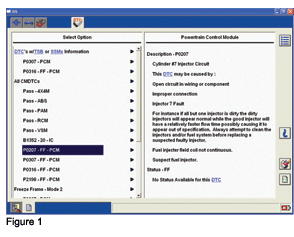 Be honest with yourself here. If you had a code for “Excessive EGR flow,” would you be looking for restricted EGR ports? If you read the code set criteria to see what the code was truly saying, you would, otherwise not likely… right? Knowing what the code is truly saying on this car opened the technician’s eyes up to look beyond just the valve, the EGR temp sensor and control transducer. It allowed him to look at something that, on the surface, seems like it would have been completely in the opposite direction of the code. What about the odd chance that one of these vehicles could have a weak coil, bad cap and rotor, or plug wires that could fire normally with the EGR closed, but having the EGR open would push the secondary resistance up just enough to misfire? Who would think to hook up a secondary ignition scope to check an EGR excessive flow code if they never read the code set criteria? Another great source of information to use to help crack the code, is the description and operation, or sometimes called theory and operation. For example, if you were to read the description and
Be honest with yourself here. If you had a code for “Excessive EGR flow,” would you be looking for restricted EGR ports? If you read the code set criteria to see what the code was truly saying, you would, otherwise not likely… right? Knowing what the code is truly saying on this car opened the technician’s eyes up to look beyond just the valve, the EGR temp sensor and control transducer. It allowed him to look at something that, on the surface, seems like it would have been completely in the opposite direction of the code. What about the odd chance that one of these vehicles could have a weak coil, bad cap and rotor, or plug wires that could fire normally with the EGR closed, but having the EGR open would push the secondary resistance up just enough to misfire? Who would think to hook up a secondary ignition scope to check an EGR excessive flow code if they never read the code set criteria? Another great source of information to use to help crack the code, is the description and operation, or sometimes called theory and operation. For example, if you were to read the description and 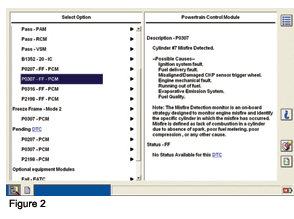 operation for the EGR system on a 1997 Buick Park Avenue, you would find that the PCM watches the MAP sensor as part of its means for measuring the EGR flow. Armed with that information, the technician can widen his inspection process beyond that of just the EGR valve. He now also can look for anything that might interfere with the MAP sensor’s measurement such as a vacuum leak.
operation for the EGR system on a 1997 Buick Park Avenue, you would find that the PCM watches the MAP sensor as part of its means for measuring the EGR flow. Armed with that information, the technician can widen his inspection process beyond that of just the EGR valve. He now also can look for anything that might interfere with the MAP sensor’s measurement such as a vacuum leak.
A common issue with those vehicles was that someone would change out the PCV valve and forget to transfer the O-ring seal from the old one to the new one. That caused a vacuum leak that would end up setting a P0401. Not knowing exactly how the system works could cause a technician to waste a lot time on repair attempts over a very simple problem, like a missing O-ring. By reviewing the system description and operation (as well as the code set criteria) before beginning pinpoint diagnostics will greatly increase the tech’s ability to go directly to the cause of the problem more quickly and more accurately.
After reviewing the code set criteria as well as the description and operation, the technician can now know how to classify the fault code to build a list of suspect parts to inspect. Typically, fault codes will fall into either one of two categories: a “condition” or a “component.” An example of a condition code is P0171 Bank 1 lean. True, the problem may be caused by a component failure, however the code is not pointing to any one component. Instead, it is pointing to an entire system of parts.
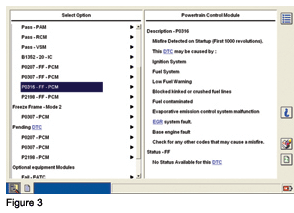 Common Codes
Common Codes
In the case of a condition code, the problem may be caused by something that is not directly a part of the electronic engine control system, but rather it has an effect over a part in the engine control system. Such is the case of a vacuum leak skewing a MAF sensor reading and causing a lean condition. In the case of a component code, the search is more direct. Unlike a condition code where the PCM is trying to say “I see a problem with this entire system’s overall operation,” a component code is much more focused. With a component code, the PCM is saying “I see a problem with this one particular part’s operation.” A good example of a component code is a P0122 TPS Sensor Circuit Low Input. Although a component code is not automatically saying to replace any one part, it is pointing directly at one part and its wiring.
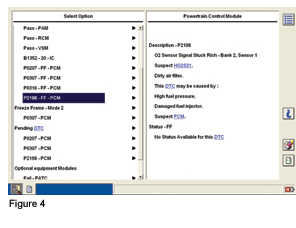 Pinpoint Testing and Inspection
Pinpoint Testing and Inspection
As the technician, you have at this point:
Extracted a fault code(s).
Reviewed the code set criteria as well as the appropriate system description and operation.
Classified the code into either a condition code or component code based on finding in the code set criteria and system operation information.
Developed a list of most likely suspect causes based on that codes classification; condition or component.
Now you have developed an informed direction to go in with your pinpoint diagnostics, and probably have only about 15 minutes invested at this point with the most foreign of vehicles to you.
This 2007 F-150 5.4L had a laundry list of fault codes (P0207, P0316, P0307 and P2198) and the complaint of a misfire. See Figures 1-4.
No need for the “deer in the head lights” look, the codes explain very well what to check. Each code is like the PCM pointing fingers at things. Applying some code set criteria, and basic theory and operation information, it’s clear what’s happening here.
The P2198 is pointing many fingers at many things on the #2 bank, including injectors among the list. Simply put, bank 2 is getting too much fuel.
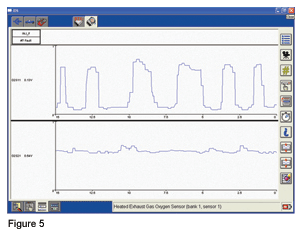 The P0307 is pointing directly at cylinder #7. You know that it is skipping on #7.
The P0307 is pointing directly at cylinder #7. You know that it is skipping on #7.
The P0207 is pointing directly at the #7 injector’s electrical condition.
What the codes are saying:
There is an electrical problem with the #7 injector. A mechanical failure will not set an injector fault code on this truck. It must be electrical. The P0207 code is set because the PCM does not see battery voltage present on the #7 injector driver (inj. ground side) when the injector is not commanded on.
We have a rich condition on that bank, so it’s likely that the injector fault is that the injector is electrically held open.
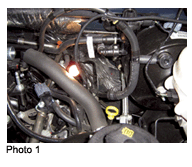
We also know that if an injector was unplugged or losing battery power, an injector fault code would set for that issue as well. However, we would have a lean code instead of rich if that were the case this time.
Looking at the problem on the scan data confirms exactly what was figured out by simply understanding why each code is set. The injector fault PID shows a fault present, while the O2 sensor for bank 2 shows a steady rich condition. See Figure 5.
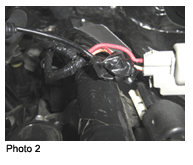 So, at this point, the direction for pinpoint testing is obvious. We’re looking for a short to ground on the grounded side of the #7 injector. This short to ground could be in the wiring or the PCM. That leaves two possible problems, but one definite direction to go in for pinpoint testing.
So, at this point, the direction for pinpoint testing is obvious. We’re looking for a short to ground on the grounded side of the #7 injector. This short to ground could be in the wiring or the PCM. That leaves two possible problems, but one definite direction to go in for pinpoint testing.
Now that a firm direction had been established, the engine was shut off and the #7 injector was unplugged. Plugging a noid light into the injector harness connector made the light shine brightly and steady. See Photo 1.
Unplugging the PCM proved that the problem was not the PCM because the light remained on. This only left the harness to blame. See Photo 2.
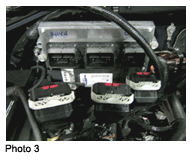
A closer look at the harness revealed an aftermarket remote start was added to the truck. The remote start system was tied to #7 injector ground side as a tach sense for the remote start module.
Since there was no disconnect point readily available, the add on wire was severed in a spot that would be easy to access for repair later. See Photo 3. The problem was cured. The problem had now been pinpointed to the aftermarket add-on equipment. Further inspection of the aftermarket wiring found a nick cut in the tach sense lead on the sharp edge of a dash support bracket.
The PCM sets fault codes in reaction to problems that it “sees.” The PCM selects which code or codes to set based on rules laid out by its programming. Understanding why the PCM has chosen the fault codes that it did is very important to tracking down the source of the fault. Being familiar with the “code set criteria” as well as the “description and operation” found in your information source prior to attempting pinpoint diagnostics will help you find a quick path to the correct answer.
| Common P0171 causes list (may vary by vehicle manufacturer):
Fuel pressure regulator Restricted fuel filter• Restricted injectors Weak fuel pump Running out of fuel in tank Restricted fuel line Ethanol fuel in tank of a non-E85 vehicle Vacuum leaks and air leaks after MAF sensor Improperly seated oil dipstick Air turbulence due to incorrect air filter or modified air filter housing Exhaust leaks before or near the O2 sensor Suck open secondary air valve Contaminated or damaged MAF sensor |








